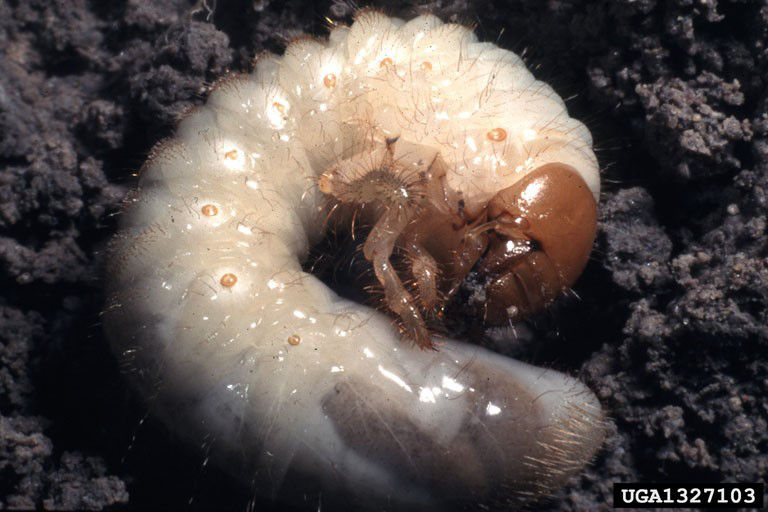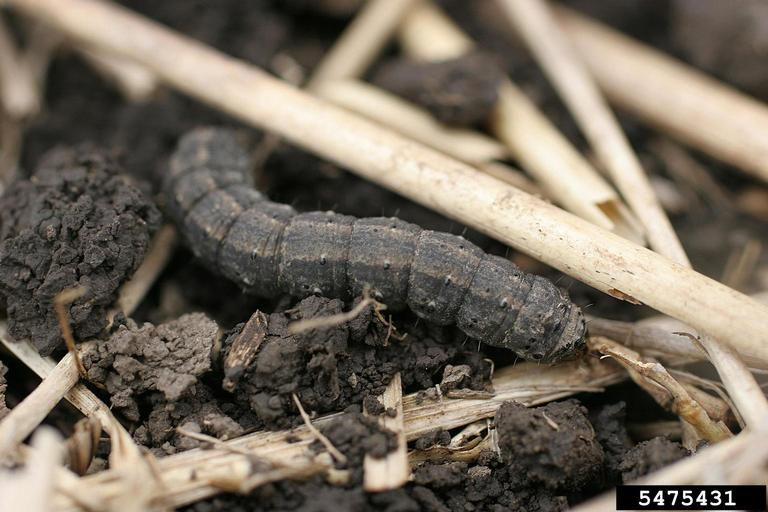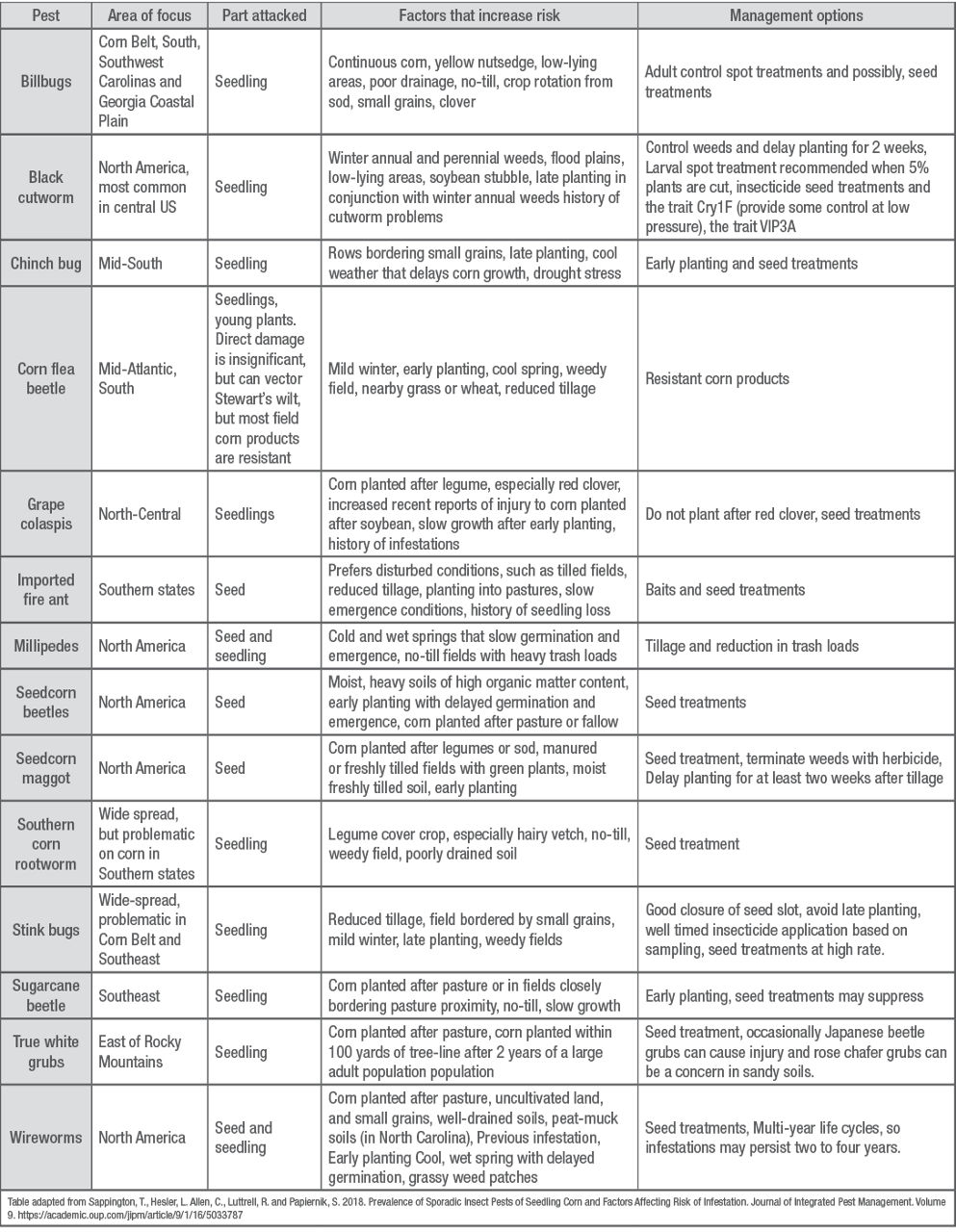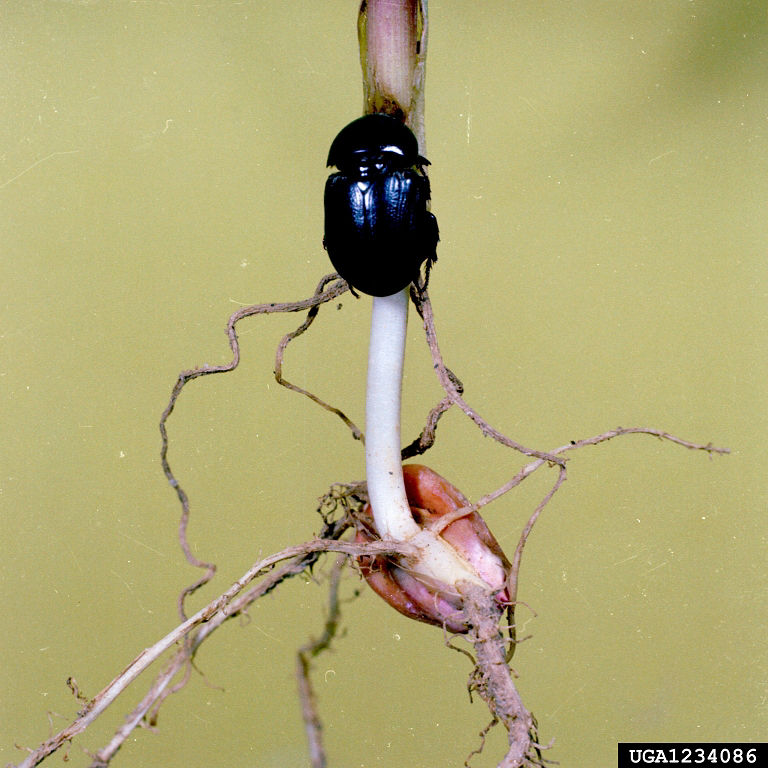15 MIN READ
Managing Seed and Seedling Insect Pest in Corn
February 25, 2021
How to Manage Seed and Seedling Insect Pest in Corn
Responsive insect pest management strategies to control seed and seedling insect pests of corn have proven to be elusive and difficult to develop for several reasons. Many of the pests are sporadic and spend a portion of their life cycle in the soil making sampling difficult. Economic injury levels for situations with injury from multiple seed or seedling pests have not been developed, complicating decisions. To overcome these challenges, growers have relied on insecticide seed treatments that provide protection during the early growth period. In a study conducted in the Mid-South, (Arkansas, Louisiana, Mississippi, and Tennessee) a neonicotinoid (insecticide) seed treatment provided an average yield increase in 8 out of 14 years when compared to seed treated only with a fungicide. The study concluded that depending on location and year, neonicotinoid seed treatments applied to corn in the Mid-South can provide significant yield and economic benefits.1 Cultural practices like planting date, tillage system, weed management, and crop sequence can help reduce the risk of injury depending on the pest. See Table 1 for more information.
Common Corn Seed Pests
Seedcorn beetles
There are two-major species collectively referred to as seed corn beetles-- the slender seedcorn beetle and the seedcorn beetle. Injury to corn is a result of adult feeding on the endosperm or mesocotyl prior to emergence. Both species feed on a wide variety of plant material and other soil inhabiting insects and, in some contexts, can be considered beneficial. The injury by seedcorn beetles is usually sporadic and patchy in a field, but injury can be economic at times and widespread throughout the field. Unfortunately, economic thresholds have not been developed for this pest complex and rescue treatments are not effective. A seed treatment is recommended if damage and subsequent stand loss dictate replanting.
Seedcorn maggot
The determining factor for an infestation of seedcorn maggot is if the field is attractive to egg laying females. The females are attracted to decaying organic matter, such as manure or green plant material incorporated into the soil with tillage. Decaying legumes are more attractive then decaying grasses, which may have implications for spring management of legume cover crops or terminating alfalfa with tillage prior to corn planting. Cover crops eliminated with herbicide and no-till fields are at lower risk to injury. Delaying planting for two to three weeks after terminating weeds or cover crops can lower the risk of injury but is often not practical as delaying planting past the optimum date for an area can result in a yield penalty.
The determining factor for an infestation of seedcorn maggot is if the field is attractive to egg laying females. The females are attracted to decaying organic matter, such as manure or green plant material incorporated into the soil with tillage. Decaying legumes are more attractive then decaying grasses, which may have implications for spring management of legume cover crops or terminating alfalfa with tillage prior to corn planting. Cover crops eliminated with herbicide and no-till fields are at lower risk to injury. Delaying planting for two to three weeks after terminating weeds or cover crops can lower the risk of injury but is often not practical as delaying planting past the optimum date for an area can result in a yield penalty.


Wireworms
Wireworms are the soil-inhabiting larvae of click beetles. Depending on geography, different species of wireworms can injure corn as well as many other crops. While there are different species of wireworm, their biology is relatively similar. Damage occurs during the larval stage, which can last two to six years. Wireworms feed on the seed and can tunnel into the mesocotyl resulting in stand reduction. Plants that survive injury are stunted and will not contribute to the final yield. While injury is usually sporadic and patchy across the field, crop rotation plays a large role in the risk of wireworm injury. The corn and soybean rotation has minimal risk of wireworm injury; however, corn following sod or grass crop mixtures are at higher risk, especially those that have been undisturbed for several years. As wireworms are most active in cooler soils, early planting followed by cool and wet conditions can increase the level of injury.
Imported fire ant
The red imported fire ant can attack the seed and cause extensive injury when populations are high within the field. In some areas of Texas, the injury can be widespread and may be related to moisture and temperature. Injury is more common in fields that have been undisturbed or in no-till production systems. Germinating seeds are more at risk, and poor planting conditions with incompletely closed furrows can allow access to the seed. Conditions that cause slow emergence are particularly vulnerable to imported fire ant damage.
Below Ground Seedling Pests
White grubs
As with wireworms, white grubs are a consortium of many species. There are white grubs with a one-year life cycle, also called annual grubs, of which Japanese beetles are an example. There are grubs which are referred to as true white grubs with a two to three-year life cycle, like June beetles. Annual grubs tend to be more sporadic and rarely result in economic injury to corn; however, the true white grub is usually a more widespread and common pest of corn. The true white grub is damaging in the second instar growth stage when larvae feed primarily on the root hairs of seedling corn. The injury can result in stand loss and plant stunting. Injury is usually more severe when corn follows sod or pasture. Additionally, fields surrounded by trees (poplar, cottonwood, willow and ash) are attractive to adults that feeding on the leaves, and lay eggs in the soil near the trees. Therefore, two years after high numbers of adults are noticed feeding on leaves, the risk of injury by second instar larvae is the highest.

Southern corn rootworm
The southern corn rootworm is widely distributed, and unlike the western and northern corn rootworm, it feeds on a wide variety of crops as both an adult and larvae and can have several generations per year. The adults can survive the winter in southern states and move northward during the growing season. The adult deposits eggs in the soil at the base of host plants. In corn, only the first generation is economically damaging. The larvae may attack the seed and be confused with wireworm injury or tunnel into the mesocotyl killing the plant or severely stunting it. Interestingly, the Bt trait that controls the western and northern corn rootworm does not provide control for this species. Injury can be more severe when a legume cover crop is used. Termination of the cover crop less than four weeks prior to planting increases the risk. No-till cropping systems that utilize a cover crop are more at risk.
Grape colaspis
The grape colaspis is a sporadic pest mainly in the Central Corn Belt. Larvae overwinter in the soil and feed on the roots of small seedlings and several are usually found feeding on single plant. While injury is spotty across the Iowa, Indiana, and Illinois corn following a legume, such as red clover, sweetclover, and to some extent alfalfa is at higher risk. Injury can be more pronounced when seedling growth is slowed. There is not a recommend sampling program or economic threshold established for this pest, as well no rescue treatments in response to injury.
Above Ground Seedling Pests
Billbug
There are several species of billbugs that can injure corn. The two major species are the southern corn billbug in the South and the maize billbug in the Corn Belt. Adults usually walk from overwintering sites to host plants, so injury is usually localized to field borders. Nutsedge and corn are the predominant hosts for both species. Adults feed on the above portion of the plant and females oviposit in their feeding punctures and the developing larvae migrate down the stem. Occasionally females deposit eggs in the soil and larvae feed on the roots. When the growing point is injured, excessive tillering and plant stunting can occur and cause plant death. In the Atlantic Coastal Plain, billbugs are a serious annual pest. Outside of this region, injury is typically sporadic and minor. Crop rotation and control of yellow nutsedge can help limit the potential for injury. Fields in continuous corn production in no-till systems are at higher risk of injury by billbugs.


Non-Insect Pests of Corn Seeds and Seedlings
Slugs
Slugs can cause injury to corn seedlings by rasping the leaf tissue resulting in long vertical lines of dead tissue. In most cases, corn can out grow the injury. Seed treatments are not effective for control of slugs. Injury is more common in no-till or reduced tillage fields and in springs followed by mild winters. For more information, read Slug Damage in Corn.
Millipedes
Millipedes are not insects but are related to them. Millipedes feed on decaying plant matter, organic matter in the soil, and other smaller soil dwelling invertebrates. However, they can occasionally feed on corn seedlings. Injury more often occurs under no-till conditions and in wet springs. This is particularly true if they can access the seed because the seed furrow did not completely close during planting. Seed treatments are not effective against millipedes.
Table 1. Common pests of corn seed and seedlings.

Sources
1 North, J.H. et. al. 2018. Value of neonicotinoid insecticide seed treatments in mid-south corn (Zea mays) production systems. Journal of Economic Entomology. Volume 111. pp. 187–192.
Reisig, D. 2015. Scouting for Seedling Insects. North Carolina State University Extension. https://entomology.ces.ncsu.edu/field-corn-insects/scouting-and-thresholds/scouting-for-seedling-insects/
Reisig, D. 2018. Are Insecticidal Seed Treatments and In-Furrow Insecticides Worth It in Corn? North Carolina State University Extension. https://entomology.ces.ncsu.edu/2018/04/are-insecticidal-seed-treatments-and-in-furrow-insecticides-worth-it-in-corn/
Sappington, T., Hesler, L. Allen, C., Luttrell, R. and Papiernik, S. 2018. Prevalence of Sporadic Insect Pests of Seedling Corn and Factors Affecting Risk of Infestation. Journal of Integrated Pest Management. Volume 9. https://academic.oup.com/jipm/article/9/1/16/5033787
2002_S2
